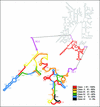In situ accessibility of Saccharomyces cerevisiae 26S rRNA to Cy3-labeled oligonucleotide probes comprising the D1 and D2 domains
- PMID: 12732564
- PMCID: PMC154520
- DOI: 10.1128/AEM.69.5.2899-2905.2003
In situ accessibility of Saccharomyces cerevisiae 26S rRNA to Cy3-labeled oligonucleotide probes comprising the D1 and D2 domains
Abstract
Fluorescence in situ hybridization (FISH) has proven to be most useful for the identification of microorganisms. However, species-specific oligonucleotide probes often fail to give satisfactory results. Among the causes leading to low hybridization signals is the reduced accessibility of the targeted rRNA site to the oligonucleotide, mainly for structural reasons. In this study we used flow cytometry to determine whole-cell fluorescence intensities with a set of 32 Cy3-labeled oligonucleotide probes covering the full length of the D1 and D2 domains in the 26S rRNA of Saccharomyces cerevisiae PYCC 4455(T). The brightest signal was obtained with a probe complementary to positions 223 to 240. Almost half of the probes conferred a fluorescence intensity above 60% of the maximum, whereas only one probe could hardly detect the cells. The accessibility map based on the results obtained can be extrapolated to other yeasts, as shown experimentally with 27 additional species (14 ascomycetes and 13 basidiomycetes). This work contributes to a more rational design of species-specific probes for yeast identification and monitoring.
Figures




Similar articles
-
In situ accessibility of small-subunit rRNA of members of the domains Bacteria, Archaea, and Eucarya to Cy3-labeled oligonucleotide probes.Appl Environ Microbiol. 2003 Mar;69(3):1748-58. doi: 10.1128/AEM.69.3.1748-1758.2003. Appl Environ Microbiol. 2003. PMID: 12620867 Free PMC article.
-
Double labeling of oligonucleotide probes for fluorescence in situ hybridization (DOPE-FISH) improves signal intensity and increases rRNA accessibility.Appl Environ Microbiol. 2010 Feb;76(3):922-6. doi: 10.1128/AEM.02456-09. Epub 2009 Dec 4. Appl Environ Microbiol. 2010. PMID: 19966029 Free PMC article.
-
Flow cytometric analysis of the in situ accessibility of Escherichia coli 16S rRNA for fluorescently labeled oligonucleotide probes.Appl Environ Microbiol. 1998 Dec;64(12):4973-82. doi: 10.1128/AEM.64.12.4973-4982.1998. Appl Environ Microbiol. 1998. PMID: 9835591 Free PMC article.
-
Oligonucleotide probes for RNA-targeted fluorescence in situ hybridization.Adv Clin Chem. 2007;43:79-115. Adv Clin Chem. 2007. PMID: 17249381 Review.
-
Programmed +1 translational frameshifting in the yeast Saccharomyces cerevisiae results from disruption of translational error correction.Cold Spring Harb Symp Quant Biol. 2001;66:249-58. doi: 10.1101/sqb.2001.66.249. Cold Spring Harb Symp Quant Biol. 2001. PMID: 12762026 Review. No abstract available.
Cited by
-
Pan-cancer analyses reveal cancer-type-specific fungal ecologies and bacteriome interactions.Cell. 2022 Sep 29;185(20):3789-3806.e17. doi: 10.1016/j.cell.2022.09.005. Cell. 2022. PMID: 36179670 Free PMC article.
-
Stress induced biofilm formation in Propionibacterium acidipropionici and use in propionic acid production.World J Microbiol Biotechnol. 2019 Jun 24;35(7):101. doi: 10.1007/s11274-019-2679-9. World J Microbiol Biotechnol. 2019. PMID: 31236717
-
An important step forward for the future development of an easy and fast procedure for identifying the most dangerous wine spoilage yeast, Dekkera bruxellensis, in wine environment.Microb Biotechnol. 2019 Nov;12(6):1237-1248. doi: 10.1111/1751-7915.13422. Epub 2019 Jun 14. Microb Biotechnol. 2019. PMID: 31197952 Free PMC article.
-
Considerations and consequences of allowing DNA sequence data as types of fungal taxa.IMA Fungus. 2018 Jun;9(1):167-175. doi: 10.5598/imafungus.2018.09.01.10. Epub 2018 May 24. IMA Fungus. 2018. PMID: 30018877 Free PMC article.
-
A Transcriptome-Targeting EcoChip for Assessing Functional Mycodiversity.Microarrays (Basel). 2011 Oct 31;1(1):25-41. doi: 10.3390/microarrays1010025. Microarrays (Basel). 2011. PMID: 27605333 Free PMC article.
References
-
- Amann, R., and W. Ludwig. 2000. Ribosomal RNA-targeted nucleic acid probes for studies in microbial ecology. FEMS Microbiol. Rev. 24:555-565. - PubMed
-
- Crockett, A. O., and C. T. Wittwer. 2001. Fluorescein-labeled oligonucleotides for real-time PCR: using the inherent quenching of deoxyguanosine nucleotides. Anal. Biochem. 290:89-97. - PubMed
-
- Fell, J. W., T. Boekhout, A. Fonseca, G. Scorzetti, and A. Statzell-Tallman. 2000. Biodiversity and systematics of basidiomycetous yeasts as determined by large-subunit rDNA D1/D2 domain sequence analysis. Int. J. Syst. E vol. Microbiol. 50:1351-1371. - PubMed
Publication types
MeSH terms
Substances
LinkOut - more resources
Full Text Sources
Molecular Biology Databases

